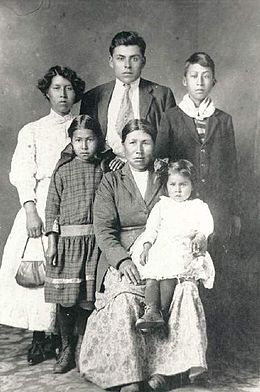Syilx
 Okanagan (Syilx) members, c. 1918. Back Left: Marriette Gregoire. Back Center: Joe Abel. Back Right: Tommy Gregoire. Left: Celestine Lewis (child). Center: Millie Williams. Right: Mary Abel (toddler). | |
| Regions with significant populations | |
|---|---|
| Canada (British Columbia), United States (Washington) | |
| Languages | |
| English,Okanagan (n̓səl̓xcin) | |
| Related ethnic groups | |
| Colville,Sanpoil,Nespelem,Sinixt,Wenatchi,Entiat,Methow,Palus,Sinkiuse-Columbia,and theNez Perce of Chief Joseph's band |
TheSyilx(Salishan pronunciation:[sjilx]) people, also known as theOkanagan,Suknaqinx,orOkinaganpeople, are aFirst NationsandNative Americanpeople whose traditional territory spans theCanada–US boundaryinWashington stateand uncededBritish Columbiain theOkanagan Countryregion.[1]They are part of theInterior Salishethnological and linguistic grouping.[2][3]The Okanagan are closely related to theSpokan,Sinixt,Nez Perce,Pend Oreille,SecwepemcandNlaka'pamuxpeoples of the same Northwest Plateau region.[1]
History
[edit]At the height of Okanagan Syilx culture, about 3000 years ago, it is estimated that 12,000 people lived in this valley and surrounding areas. The Syilx employed an adaptive strategy, moving within traditional areas throughout the year to fish, hunt, or collect food, while in the winter months, they lived in semi-permanentvillagesofkekulis,a type of pithouse.[4]In Nsyilxcn pit house is q̓ʷc̓iʔ.[5]
When theOregon Treatypartitioned thePacific Northwestin 1846, the portion of the tribe remaining in what becameWashington Territoryreorganized underChief Tonasketas a separate group from the majority of the Syilx, whose communities remain in Canada.[1]The Okanagan Tribal Alliance, however, incorporates the American branch of the Syilx. The latter are part of theConfederated Tribes of the Colville,a multi-tribal government in Washington state.[6][7]
The bounds of Syilx territory are roughly the basin ofOkanagan Lakeand theOkanagan River,plus the basin of theSimilkameen Riverto the west of theOkanagan valley,and some of the uppermost valley of theNicola River.The various Syilx communities inBritish ColumbiaandWashingtonform theOkanagan Nation Alliance,a border-spanning organization which includes American-side Syilx residents in theColville Indian Reservation,where the Syilx are sometimes known as Colvilles.[8][1]
TheUpper Nicola Indian Band,a Syilx group of theNicola Valley,which was at the northwestern perimeter of Okanagan territory, are known in their dialect as theSpaxomin,and are joint members in a historic alliance with neighbouring communities of theNlaka'pamuxin the region known as theNicola Country,which is named after the 19th-century chief who founded the alliance,Nicola.This alliance today is manifested in theNicola Tribal Association.[9]
Language
[edit]The language of the Syilx people is Nsyilxcn. "Syilx" is at the root of the language name Nsyilxcn, surrounded by a circumfix indicating a language.[10]When writing Nsyilxcn, no capital letters are used.[11]Nsyilxcn is an Interior Salish language that is spoken across theCanada–United States borderin the regions of southern British Columbia and northern Washington.[12]This language is currently endangered and has only 50 fluent speakers remaining.[12]
Governments
[edit]- Okanagan Nation Alliance[13]
- Westbank First Nation(Westbank) (tqłəníw̓t/sn̓qatqłəníw̓t)
- Lower Similkameen Indian Band(Keremeos) (n̓iʔxʷín̓aʔ)
- Upper Similkameen Indian Band(Keremeos) (tk̓r̓miw̓s)
- Osoyoos Indian Band(swiw̓s)
- Penticton Indian Band(sn̓pin̓tktn̓)
- Okanagan Indian Band(Vernon) (n̓k̓maplqs)
- Upper Nicola Indian Band(Douglas Lake) - also part of theNicola Tribal Association(spax̌mn̓)
- Confederated Tribes of the Colville(sx̌ʷy̓ʔiłpx sqlxʷúlaʔxʷ)
Population history
[edit]According toJames Teitin year 1780 the Okinagan (Syilx) numbered around 3,000 people.
See also
[edit]References
[edit]- ^abcdLozar, Patrick (2018-07-01).""My Home Is on Both Sides": Indigenous Communities and the US-Canadian Border on the Columbia Plateau, 1880s–1910s ".Ethnohistory.65(3): 391–415.doi:10.1215/00141801-4451374.ISSN0014-1801.
- ^Noonan, Michael; Mattina, Anthony (June 1989)."Colville-Okanagan Dictionary".Language.65(2): 433.doi:10.2307/415365.ISSN0097-8507.JSTOR415365.
- ^Peacock, Sandra L. (February 2008)."From complex to simple: balsamroot, inulin, and the chemistry of traditional Interior Salish pit-cooking technologyThis paper was submitted for the Special Issue on Ethnobotany, inspired by the Ethnobotany Symposium organized by Alain Cuerrier, Montréal Botanical Garden, and held in Montréal at the 2006 annual meeting of the Canadian Botanical Association/l'Association Botanique du Canada".Botany.86(2): 116–128.doi:10.1139/b07-111.ISSN1916-2790.
- ^John D. Greenough, Murray A. Roed, ed. (2004).Okanagan Geology.Kelowna Geology Committee. pp. 71–83.ISBN0-9699795-2-5.
- ^"English - Cv-Ok".meltr.org.Retrieved2024-04-02.
- ^Dulic, Aleksandra; Thorogood, Miles; Sam, Marlowe; Correia, Maria; Alexis, Sarah; Armstrong, Jeanette (2023-11-20)."Okanagan Waterways Past, Present and Future: Approaching Sustainability through Immersive Museum Exhibition".Sustainability.15(22): 16109.doi:10.3390/su152216109.ISSN2071-1050.
- ^Gooding, Susan Staiger (1994)."Place, Race, and Names: Layered Identities in United States v. Oregon, Confederated Tribes of the Colville Reservation, Plaintiff-Intervenor".Law & Society Review.28(5): 1181–1229.doi:10.2307/3054027.ISSN0023-9216.JSTOR3054027.
- ^Terbasket, Pauline (2019-08-25)."Syilx Perspective on Original Foods: Yesterday, Today, and Tomorrow".Journal of Agriculture, Food Systems, and Community Development:1–6.doi:10.5304/jafscd.2019.091.016.ISSN2152-0801.
- ^Nicholas, George P. (2006)."Decolonizing the Archaeological Landscape: The Practice and Politics of Archaeology in British Columbia".The American Indian Quarterly.30(3): 350–380.doi:10.1353/aiq.2006.0031.ISSN1534-1828.
- ^Johnson, M. K. (2012). k^sup w^u_sq^sup w^a?q^sup w^a?álx (we begin to speak): Our journey within Nsyilxcn (Okanagan) language revitalization.Canadian Journal of Native Education, 35(1), 79.
- ^reporter, Athena Bonneau, Local Journalism Initiative (2021-07-24)."Penticton Museum's new exhibit honours four Syilx language keepers".IndigiNews.Retrieved2024-04-02.
{{cite web}}:CS1 maint: multiple names: authors list (link) - ^abJohnson, Sʔímlaʔx Michele K. (November 2017). "Syilx Language House: How and Why We Are Delivering 2,000 Decolonizing Hours in Nsyilxcn".Canadian Modern Language Review.73(4): 509–537.doi:10.3138/cmlr.4040.ISSN0008-4506.S2CID149072885.
- ^Syilx (Okanagan) LanguageNames:Upper Nicola Band. "Syilx Place Names". Facebook, October 5, 2020.https://www.facebook.com/watch/?v=1057161971367609.
Further reading
[edit]- Armstrong, Jeannette, and Lee Maracle, Okanagan Rights Committee; Delphine Derickson, Okanagan Indian Education Resource Society,We Get Our Living Like Milk from the Land,Theytus Books, 1994
- Boas, Franz(1917).Folk-tales of Salishan and Sahaptin tribes.Published for the American Folk-Lore Society by G.E. Stechert & Co.ISBN9780659903273.Available online through the Washington State Library's Classics in Washington History collectionIncludes:Okanagon talesby James A. Teit andOkanagon talesby Marian K. Gould.
- Carstens, Peter.The Queen's People: A Study of Hegemony, Coercion, and Accommodation Among the Okanagan of Canada.Toronto: University of Toronto Press, 1991.ISBN0-8020-5893-0
- Robinson, Harry, and Wendy C. Wickwire.Nature Power: In the Spirit of an Okanagan Storyteller.Vancouver: Douglas & McIntyre, 1992.ISBN1-55054-060-2
